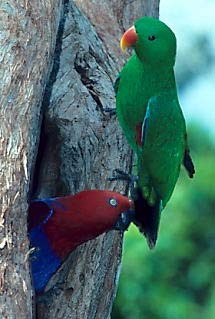Rare Among Birds, Parrot Mom Gets the Cool Colors

In the animal kingdom, males typically get all the color, which they flaunt in the neverending quest for sex.
Males use color, size, antlers and other showy tactics to discourage males (or in some cases, to beat them up).
Now and then, the reverse is true.
Usually when females are the most colorful, however, it's because sex roles have been reversed: The females are competing for mates and the males are tending the young.
So the parrot Ecletus roratus has been an enigma. The females stay in the nest while the males forage -- a typical avian family setup. Females are well outnumbered, so they don't have to show off to get a mate.
Yet while the males are plain tree-leaf green, the females stand out like 4th of July fireworks, brightly adorned with red and blue.
Mom and Dad are so different that when scientists first found them in the Australian rainforest, they though it was two different species.
Get the world’s most fascinating discoveries delivered straight to your inbox.
A new study suggests an evolutionary logic for the odd coloring.
Australian National University researcher Robert Heinsohn and colleagues looked at the birds through avian eyes. Birds see color differently. Correcting for this was an eye-opener.
The male E. roratus roams widely in search of food. His simple green makes him hard to see against the forest's leaves, protecting him from predators. But against a tree trunk back home, he stands out, which Heinsohn says should help him attract a mate.
She, on the other hand, must fiercely defend her hole in the tree, a scarce nesting commodity for these parrots and other species.
"Females may kill each other in disputes over hollows," the scientists report in the July 21 issue of the journal Science.
The brilliant coloring comes in handy before nesting.
A female's plumage makes her stand out against leaves. The researchers realized that a competitor's first view of a potential nest tree is typically from above, and that's where a female spend most of her time just prior to breeding, parading her colors to let the others know the tree is taken.
- The Chemistry of Parrot Coloring
- The Real Reason Animals Flaunt Size and Color
- No Birdbrain, Parrot Grasps Concept of Zero
- Survival Skills: Why Sex is Good
Robert is an independent health and science journalist and writer based in Phoenix, Arizona. He is a former editor-in-chief of Live Science with over 20 years of experience as a reporter and editor. He has worked on websites such as Space.com and Tom's Guide, and is a contributor on Medium, covering how we age and how to optimize the mind and body through time. He has a journalism degree from Humboldt State University in California.



